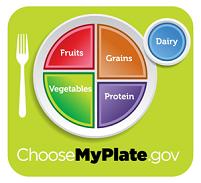My Plate Guidelines
The My Plate Guidelines, developed in 2011, are the revised healthy eating guidelines developed by the USDA for healthy diet habits! The new food guidelines promise to end nutrition confusion and are greatly simplified. The food pyramid is gone. Now we find a plate called "Choose My Plate".
It is a visual representation of what your actual plate with food should look like. You can quickly look and see if you are eating correctly, or if those grains are out of control again!

Your plate has room for 5 food groups, and the My Plate Guidelines are:
- Fruits: Any fruits are recommended or 100% fruit juice. Fruit can be fresh, canned frozen, or dried and can be whole, cut up or pureed. The amount of fruits that you need is determined by your age but women should eat 1.5 cups per day and men 2 cups per day.
- Vegetables: Any vegetable or 100% veggie juice counts. Vegetables can be raw, cooked, frozen, canned, dried and can be whole, cut up or mashed. The total amount of veggies is also determined by age but women should get 2 cups and men 3 cups per day.
- Grains: Any food made from wheat, rice, oats, cornmeal, barley or another cereal grain is a grain product. Bread, pasta, oatmeal, breakfast cereals, tortillas, and grits are examples of grains. Grain guidelines vary between 3 to 8 oz equivalents depending on your age and sex and half of them should be whole grain.
- Protein Foods: All foods made from meat, poultry, seafood, beans and peas, eggs, processed soy products, nuts and seeds. Eat a variety of these foods and at least 8 oz. of seafood per week. Choose lean protein.
- Dairy: All fluid milk products and choose fat-free or low-fat or calcium fortified soy milk. Also included are puddings, ice cream, frozen yogurt, cheeses, and yogurt. Boys, girls, women, and men need 3 cups of milk per day.
- Oils: Oils are not included in the food guidelines but they have essential nutrients and are included in the USDA patterns. They recommend eating healthy oils and most Americans eat more than enough in their diet. Good choices are salad dressings, nuts, fish, and cooking oils! The average adult should eat between 5 to 7 teaspoons of oil, which is not much!
Empty Calories: Foods and drinks that contain extra calories from fats or sugar, but few or no nutrients. The average person should only allow a small amount per day!
The rules that the My Plate Guidelines encourage are:
BALANCING CALORIES:
- Enjoy your food, but eat less.
- Avoid oversized portions.
FOODS TO INCREASE:
- Make half of your plate fruits and vegetables.
- Make at least half your grains whole grains.
- Switch to fat-free or low-fat (1%) milk
FOODS TO REDUCE:
- Compare sodium in foods like soup, bread, and frozen meals - and choose the foods with lower numbers.
- Drink water instead of sugary drinks.
*****
The My Plate Guidelines are a step in the right direction if you are trying to make lifestyle solutions and incorporate more healthy foods. I thought that it was interesting that sweets, oils and foods that are empty calories were not included at all on the plate. They were included in the website, but buried. A small amount of empty calories is okay, but most people eat far more than is healthy was their advice!
See the Half Plate Rule for additional information!
Facebook - Like This Page?
Facebook - Like This Site?

Please Check out my other Website!
We will be moving the Healthy Diet Habits Website to the Holiday site!

US and Around the World - Includes the many Health Awareness Days/Weeks/Months
Lots of Food Holidays and Holiday Food Tips!!
Related Pages

Healthy Eating

- Food Guidelines
- My Plate Guidelines
- Fruit Guidelines
- Vegetable Guidelines
- Grain Guidelines
- Protein Food Guidelines
- Beans
- Dairy Guidelines
- Oil Guidelines
- Empty Calories
- Mediterranean Food Guidelines
- Eat Right America Program








